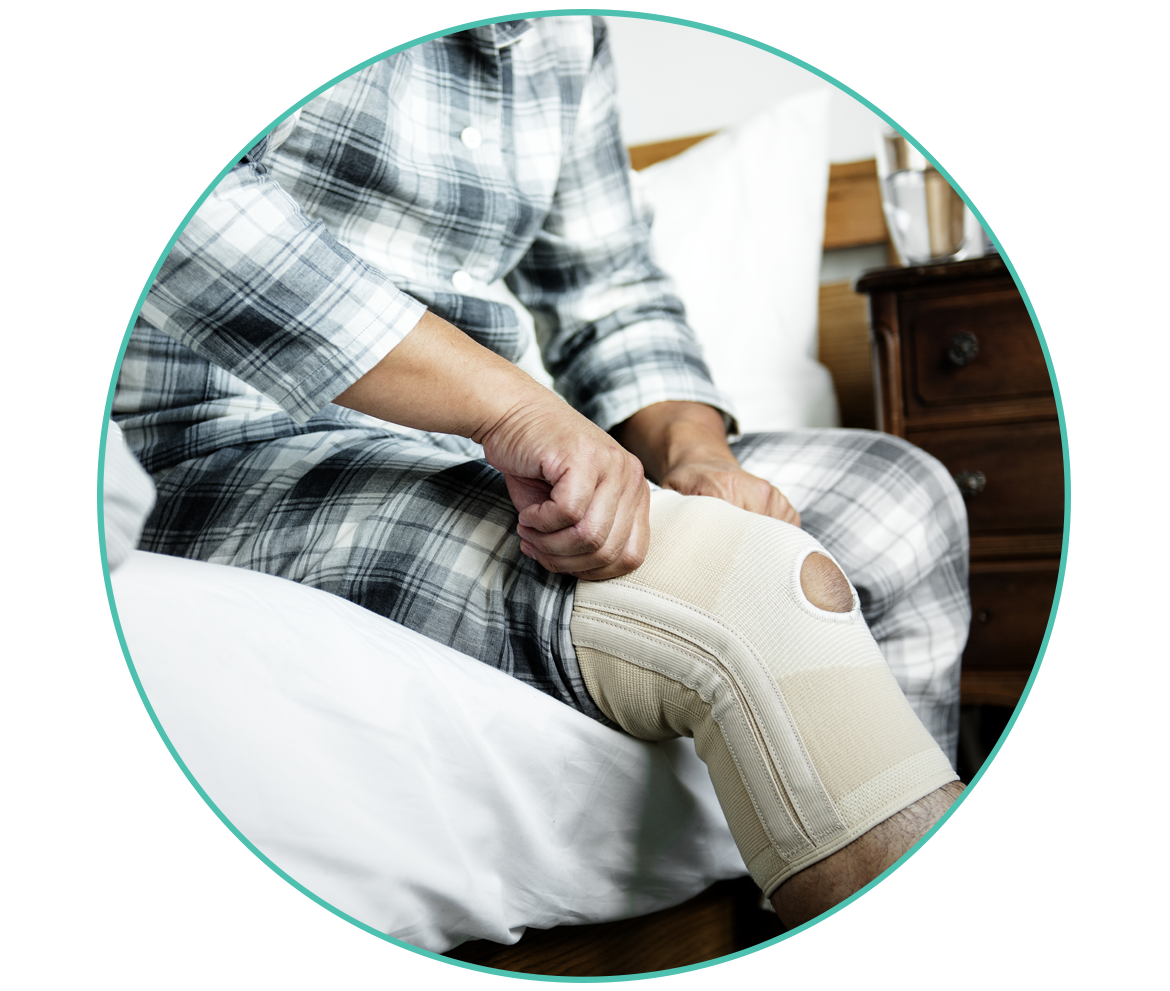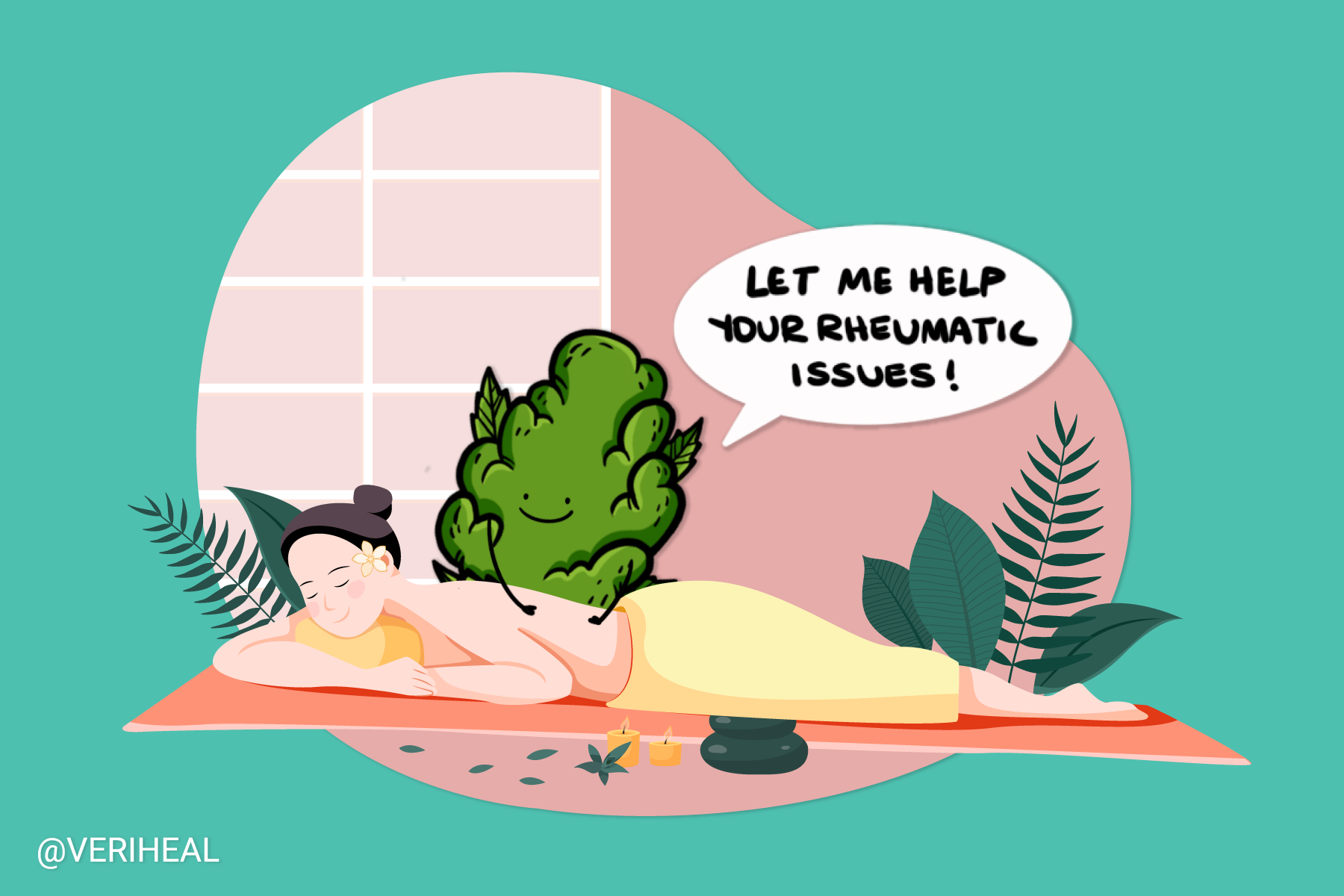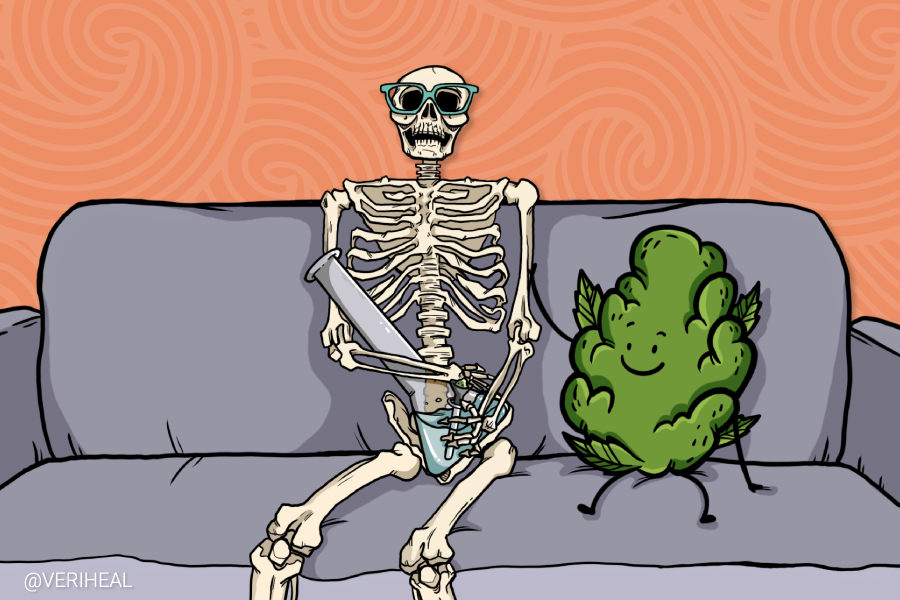Improving Arthritis Pain Symptoms with Medical Marijuana

- How Cannabinoids Reduce Arthritis Pain
- Understanding the Different Types of Arthritis
- What are Researcher’s Finding?
Arthritis is a type of arthropathy or disease of the joint. Many other types of arthropathies exist including gout, calcium pyrophosphate deposition (CPPD), rheumatoid, infectious, hemophiliac, and several inflammatory and neurologic types. Osteoarthritis is the most common arthropathy of the knee. It is a chronic and painful condition that causes inflammation and pain in the joints including the hands, feet, knees, hips, and spine. For many patients living with this chronic inflammation, traditional prescription medications like opioids and other analgesics (painkillers) are not enough. Thankfully many patients find relief from their chronic pain with the medical use of marijuana.
There are about 150 identified cannabinoids in cannabis (15). The major two include cannabidiol (CBD) and Δ9-tetrahydrocannabinol (THC). These interact with the endocannabinoid system, a system that basically uses self-made cannabinoids (known as endocannabinoids) to activate and influence other neurotransmitters in the body. THC and CBD act as fat-based neurotransmitters when they encounter CB1 and CB2 cannabinoid receptors (11).
Researchers believe that CB1 and CB2 receptors, along with other cannabinoid-sensitive receptors like TRPV, are present in joint, bone, skin, and nerve tissues. For example, this can be seen in synovial, or the fluid surrounding the joint, biopsies of patients undergoing total knee arthroplasty with osteoarthritis (OA) and rheumatoid arthritis (RA), as well as animal models. In addition, these patients have higher volumes of the endocannabinoids anandamide (AEA) and 2-arachidonoylglycerol (2-AG), which can be directly influenced by the use of cannabis (11).
In other words, CB1 receptors in the joint tissue of the knee and on nerves are activated by cannabis, and in turn, may decrease pain and inflammation (16). In addition, CBD has been shown to block the progression of arthritis via an immunosuppressive pathway in RA mouse models (11).
Check out our endocannabinoid guide to learn more about the endocannabinoid system and our chronic pain page for more information about how cannabis reduces pain.
How Cannabinoids Reduce Arthritis Pain
THC has the ability to interact with both CB1 and CB2 receptors, among some others, allowing it to regulate the systems responsible for pain perception and immune reactions; this is what gives it the potential to alter pain perception and decrease inflammation in the body (10).
If you are concerned about the psychoactive and perception-altering effects of THC, it is a viable option to focus on treating your arthritis-related pain with CBD only, which counteracts the adverse effects of THC, like anxiety, when taken in combination (18). It can also regulate pain perception and has anti-inflammatory effects (10).
In a 2015 preclinical study, topical CBD gel applied to arthritic mice was shown to reduce pain, joint swelling, joint space narrowing, pro-inflammatory markers, and immune cell infiltration. CBD did not cause apparent psychoactive or other adverse effects in the study, suggesting that it is a good candidate for further arthritis study in humans (19). If you are experiencing other symptoms that go along with having a chronic condition such as anxiety or insomnia, CBD may be able to help these conditions as well (10).
The Canadian Arthritis Society recommends that patients who have never used marijuana start with a low dose and increase it over the following days and weeks (10). They also recommend using cannabis that has higher CBD content, such as 20:1, 2:1, or 1:1 CBD to THC ratios (9).
In addition, they recommend using oils, tinctures, and capsules because these cannabis products are easier to fine-tune dosages with (9). Taking marijuana orally and with products that dissolve under the tongue can provide several hours of effects in comparison to smoking it (which sets in within minutes but usually only lasts one to a few hours) (20). Cannabinoids can also accumulate in the body over time, and the long-term effects aren’t yet fully known. Using topicals such as lotions, creams, and oils that contain low THC and higher amounts of CBD may also provide you with symptom relief and should not have any intoxicating effects.
Understanding the Different Types of Arthritis
It is important to note that there are more than 100 different types of arthritis and what works for one type may not work for others when it comes to joint pain management and stiffness (14). As always, it is important to talk with the doctor or rheumatologist managing your arthritis care about how medical marijuana can be taken alone or in combination with other prescriptions to help this condition.
In addition, rheumatoid arthritis patients are recommended to continue conventional prescription therapies as these drugs can help prevent the permanent joint damage from progressing (14). The Canadian Rheumatology Association recommends not using medical marijuana to treat RA in patients under 25 due to an increased risk of cognitive issues from high THC products (9).
There are five main categories of arthritis. Please keep in mind that arthritis can affect the knees, hands, spine, hips, and other joints in the body, creating several specific subtypes.
Osteoarthritis (OA)
- Is the most common form of arthritis (12)
- Caused when the cartilage in a joint breaks-down and the bone begins to change (12)
- Also known as degenerative joint disease or “wear and tear” arthritis (12)
- Occurs most often in the hands, hips, and knees (12)
- Causes pain, stiffness, swelling, and decreased range of motion in the joint (12)
- It can reduce a person’s daily function and lead to disability (12)
- Can be passed on genetically (12)
- Women over 50 are more likely to develop OA than men (12)
Visit our page on osteoarthritis for more information.
Rheumatoid Arthritis (RA)
- Considered an autoimmune and inflammatory disease because the immune system attacks healthy tissues by mistake (13)
- Usually attacks multiple joints at once including the hands, wrists, and knees (13)
- Causes joint tissue inflammation and tissue damage, chronic joint pain, stiffness, swelling, weight loss, fatigue, and weakness (13)
- Can affect tissues throughout the body including the lungs, heart, and eyes (13)
- RA is 2 to 3 times higher in women than men (13)
- Can be genetic in human leukocyte antigen (HLA) genes (13)
Check out our page on treating rheumatoid arthritis for more information.
Fibromyalgia
- Abnormal pain processing that causes pain all over the body (4)
- Causes pain and stiffness all over the body; fatigue; depression and anxiety; sleep problems; headaches; and issues with thinking and concentration (4)
- Other issues include tingling in hands and feet and temporomandibular joint syndrome (TMJ) (4)
- Also causes digestive problems including abdominal pain, bloating, constipation, and irritable bowel syndrome (IBS) (4)
Visit our page on fibromyalgia for more information.
Gout
- Caused by hyperuricemia, a condition where the body overproduces uric acid and uric acid crystals build up in the joints, fluids, and tissues in the body (6)
- Occurs in one joint at a time (6)
- Often found in toe joints, the ankle, and the knee (6)
- Causes swelling, intense joint pain, swelling, and redness (6)
- More common in men and people who are obese, have diabetes, and drink alcohol (6)
- Caused by diets high in purines that are found in red meat, sardines, mussels, tuna, scallops, and trout (6)
- Comes and goes with flares and remissions (6)
You can learn more about treating gout with medical marijuana here.
Childhood Arthritis
- Can cause permanent physical damage to joints in children (3)
- The most common type is juvenile idiopathic arthritis (JIA) (3)
- Cannot be cured, but can go into remission (3)
- Patients experience symptom flares that include joint pain, swelling, stiffness, fever, rash, fatigue, loss of appetite, and eye inflammation (3)
- Unknown causes, but autoimmune issues are suspected (3)
What are Researchers Finding?
A 2019 Danish study focused on THC and its usefulness for treating RA and ankylosing spondylitis, both inflammatory chronic diseases. This study was a double-blind and placebo-controlled study that took course over a 12-week period that was followed by a 12-week observational period, and a follow-up visit at 36 weeks (7). Many of these patients did not see improvements with CBD alone before participating in the study.
The results of this study are promising because patients saw an improvement in pain scores at the end of 12 weeks and many reported improved quality of life measures after 24 and 36 weeks (7). Though more research is needed on marijuana use and arthritis, this study along with the preclinical 2015 transdermal CBD gel study, show the potential THC and CBD have in helping reduce arthritis symptoms (17) (20).
Note: Veriheal does not intend to give this as professional medical advice. Do not attempt to self-diagnose or prescribe treatment based on the information provided on this page. Always consult a physician before making any decision on the treatment of a medical condition.
1. Biles, M. (2020, April 03). CBD as a Steroid Sparing Treatment. Retrieved January 31, 2021, from https://www.projectcbd.org/medicine/cbd-steroid-sparing-treatment
2. CBD for Arthritis Pain: What You Should Know. (2019). Retrieved January 31, 2021, from https://www.arthritis.org/health-wellness/healthy-living/managing-pain/pain-relief-solutions/cbd-for-arthritis-pain
3. Childhood Arthritis. (2020, July 27). Retrieved January 31, 2021, from https://www.cdc.gov/arthritis/basics/childhood.htm
4. Fibromyalgia. (2020, January 06). Retrieved January 31, 2021, from https://www.cdc.gov/arthritis/basics/fibromyalgia.htm
5. Gonen, T., & Amital, H. (2020). Cannabis and Cannabinoids in the Treatment of Rheumatic Diseases. Rambam Maimonides medical journal, 11(1), e0007. https://www.rmmj.org.il/issues/44/articles/1025
6. Gout. (2020, July 27). Retrieved January 31, 2021, from https://www.cdc.gov/arthritis/basics/gout.html
7. Hendricks, O., Andersen, T. E., Christiansen, A. A., Primdahl, J., Hauge, E. M., Ellingsen, T., Horsted, T. I., Bachmann, A. G., Loft, A. G., Bojesen, A. B., Østergaard, M., Lund Hetland, M., Krogh, N. S., Roessler, K. K., & Petersen, K. H. (2019). Efficacy and safety of cannabidiol followed by an open label add-on of tetrahydrocannabinol for the treatment of chronic pain in patients with rheumatoid arthritis or ankylosing spondylitis: protocol for a multicentre, randomised, placebo-controlled study. BMJ open, 9(6), e028197. https://bmjopen.bmj.com/content/9/6/e028197
8. Katz-Talmor, D., Katz, I., Porat-Katz, BS. et al. Cannabinoids for the treatment of rheumatic diseases — where do we stand?. Nat Rev Rheumatol 14, 488–498 (2018). https://www.nature.com/articles/s41584-018-0025-5
9. Medical Cannabis. (n.d.). Retrieved January 31, 2021, from https://arthritis.ca/treatment/medication/medical-cannabis
10. Medical Cannabis & Arthritis. (2019). Retrieved January 31, 2021, from https://arthritis.ca/AS/courses/medical-cannabis-arthritis/content/index.html#/lessons/aG2-dk4r8fT37HeH_2nVeL7GwJRRQ6Jx
11. Miller, R. J., PhD, & Miller, R. E., PhD. (2017, October 9). Is Cannabis an Effective Treatment for Joint Pain? [PDF]. Chicago: Clinical and Experimental Rheumatology. https://www.clinexprheumatol.org/article.asp?a=12225
12. Osteoarthritis (OA). (2020, July 27). Retrieved January 31, 2021, from https://www.cdc.gov/arthritis/basics/osteoarthritis.htm
13. Rheumatoid Arthritis (RA). (2020, July 27). Retrieved January 31, 2021, from https://www.cdc.gov/arthritis/basics/rheumatoid-arthritis.html
14. Robert H. Shmerling, M. (2020, April 09). Does CBD help with arthritis pain? Retrieved January 31, 2021, from https://www.health.harvard.edu/blog/does-cbd-help-with-arthritis-pain-2020041019418
15. Citti, C., Linciano, P., Russo, F., Luongo, L., Iannotta, M., Maione, S., . . . Cannazza, G. (2019). A novel phytocannabinoid isolated from cannabis sativa l. with an in vivo cannabimimetic activity higher than δ9-tetrahydrocannabinol: Δ9-tetrahydrocannabiphorol. Scientific Reports, 9(1). https://www.nature.com/articles/s41598-019-56785-1
16. Nickles, M. A., & Lio, P. A. (2020). Cannabinoids in dermatology: Hope or hype? Cannabis and Cannabinoid Research, 5(4), 279-282. https://www.liebertpub.com/doi/10.1089/can.2019.0097
17. Iffland, K., & Grotenhermen, F. (2017). An update on safety and side effects of Cannabidiol: A review of clinical data and relevant animal studies. Cannabis and Cannabinoid Research, 2(1), 139-154. https://www.liebertpub.com/doi/10.1089/can.2016.0034
18. Grotenhermen, F., Russo, E., & Zuardi, A. W. (2017). Even High Doses of Oral Cannabidiol Do Not Cause THC-Like Effects in Humans: Comment on Merrick et al. Cannabis and Cannabinoid Research 2016;1(1):102-112; DOI: 10.1089/can.2015.0004. Cannabis and cannabinoid research, 2(1), 1–4. https://www.liebertpub.com/doi/10.1089/can.2016.0036
19. Hammell, D. C., Zhang, L. P., Ma, F., Abshire, S. M., McIlwrath, S. L., Stinchcomb, A. L., & Westlund, K. N. (2016). Transdermal cannabidiol reduces inflammation and pain-related behaviours in a rat model of arthritis. European journal of pain (London, England), 20(6), 936–948. https://www.ncbi.nlm.nih.gov/pmc/articles/PMC4851925/
20. Millar, S. A., Stone, N. L., Yates, A. S., & O’Sullivan, S. E. (2018). A Systematic Review on the Pharmacokinetics of Cannabidiol in Humans. Frontiers in pharmacology, 9, 1365. https://www.ncbi.nlm.nih.gov/pmc/articles/PMC6275223/

















